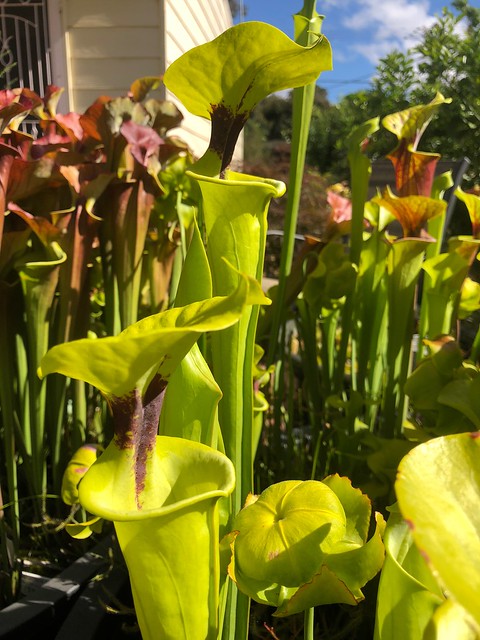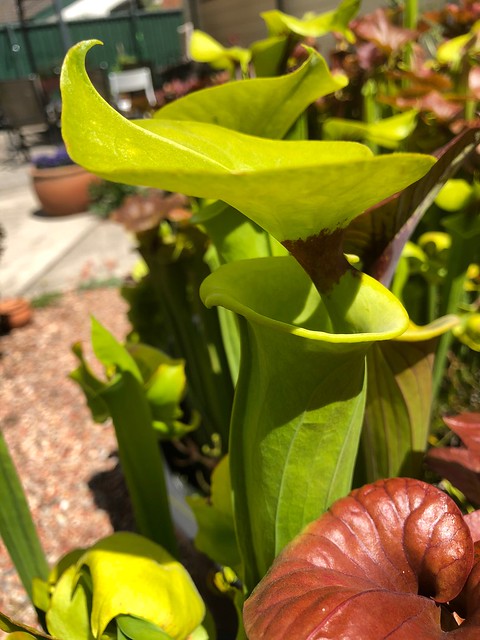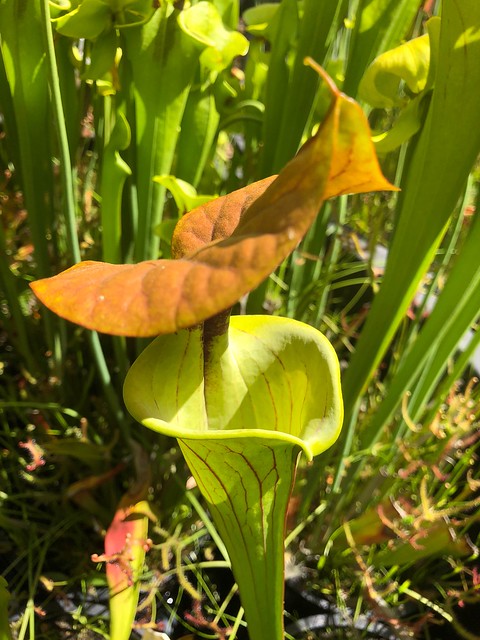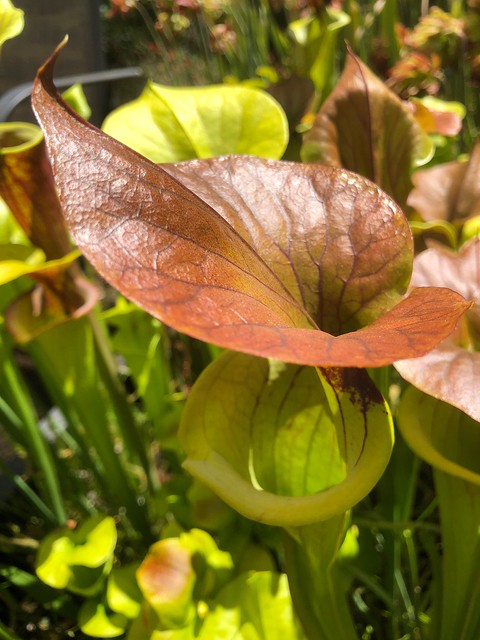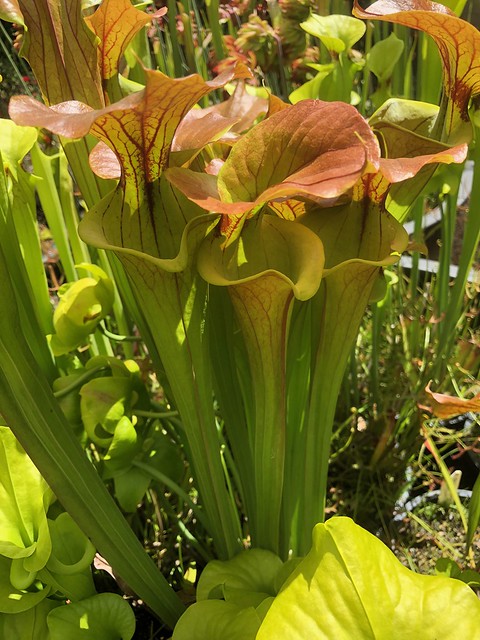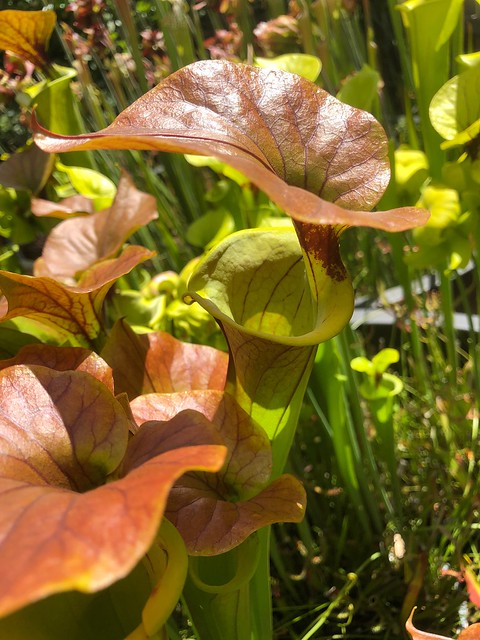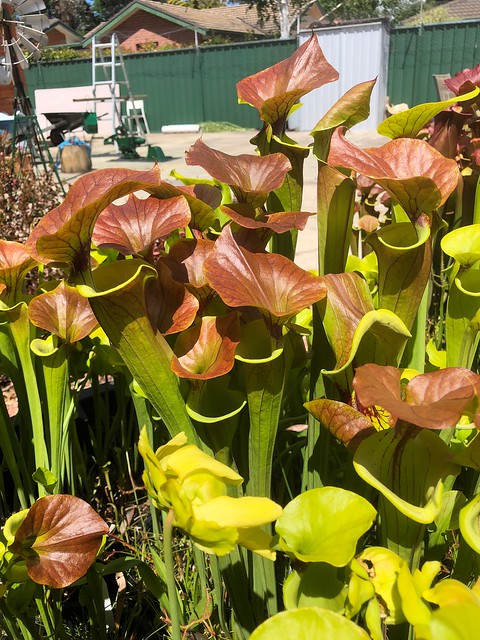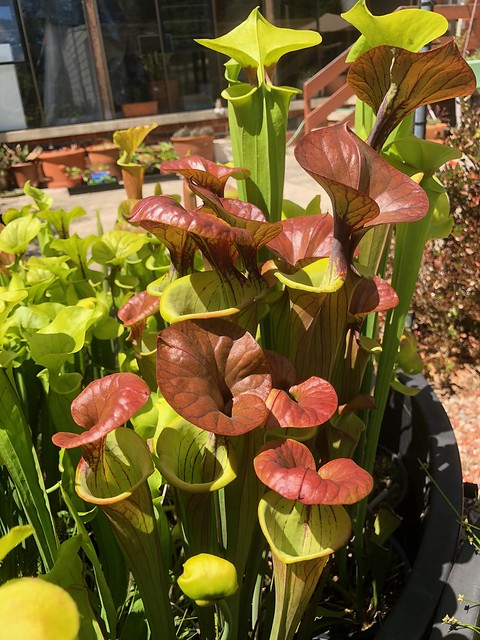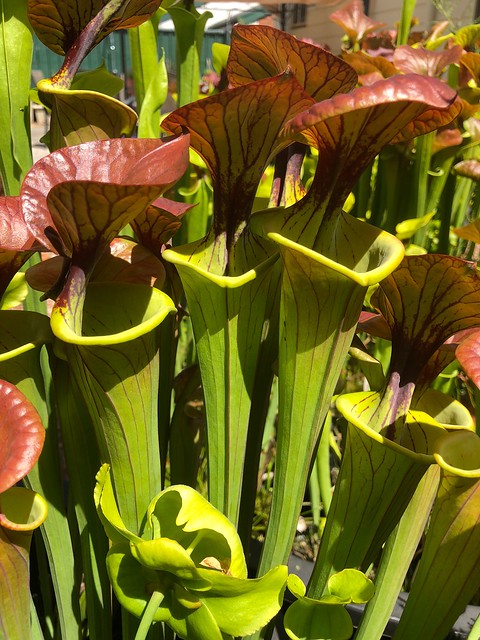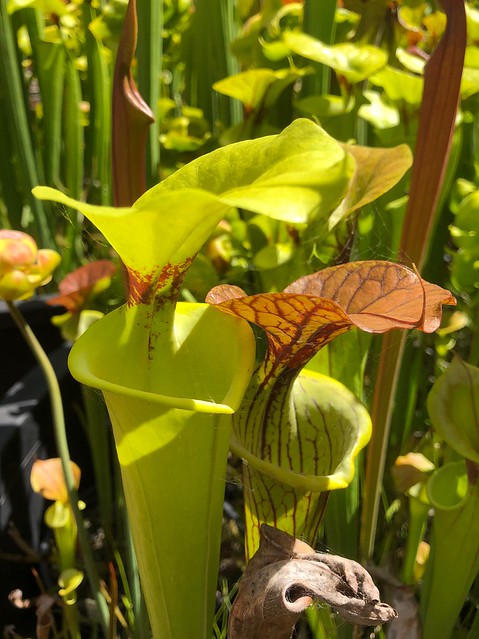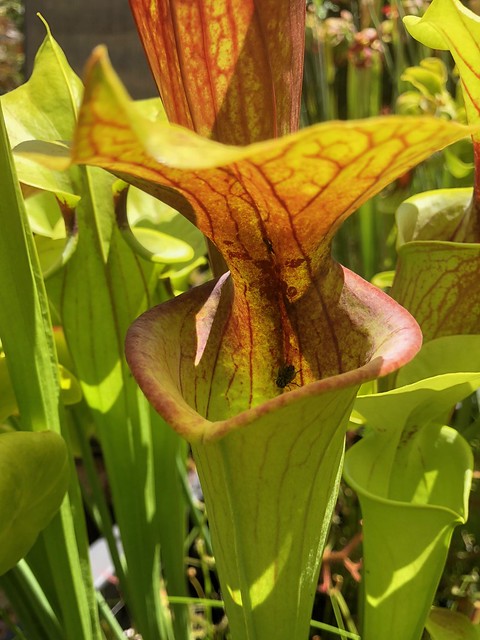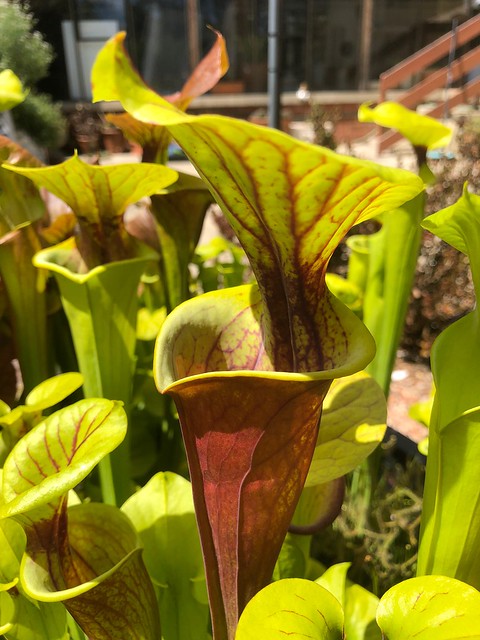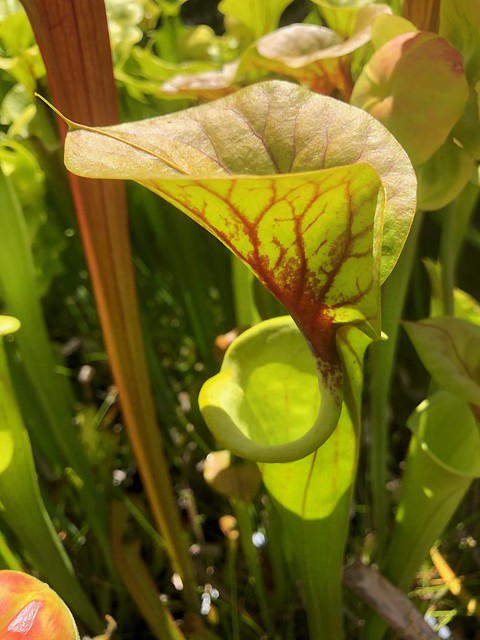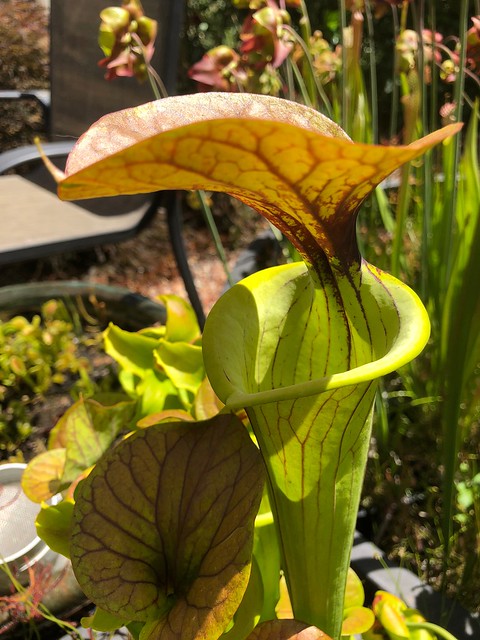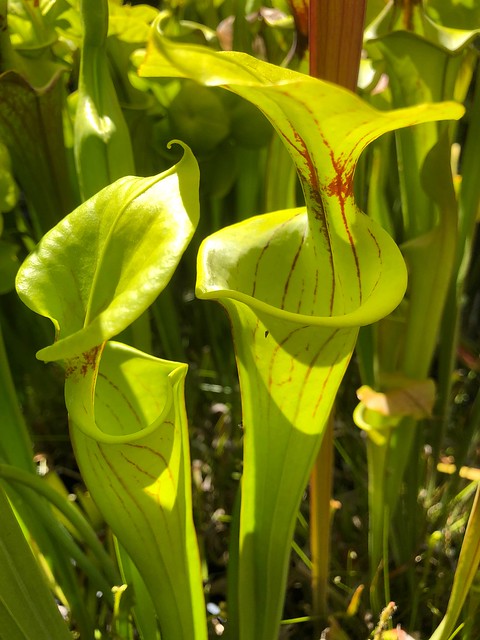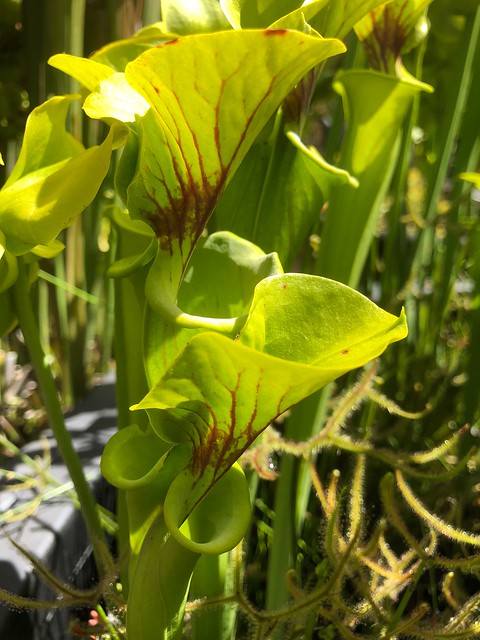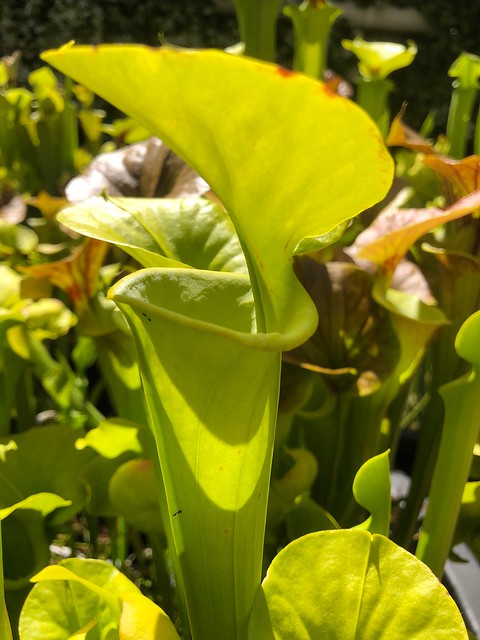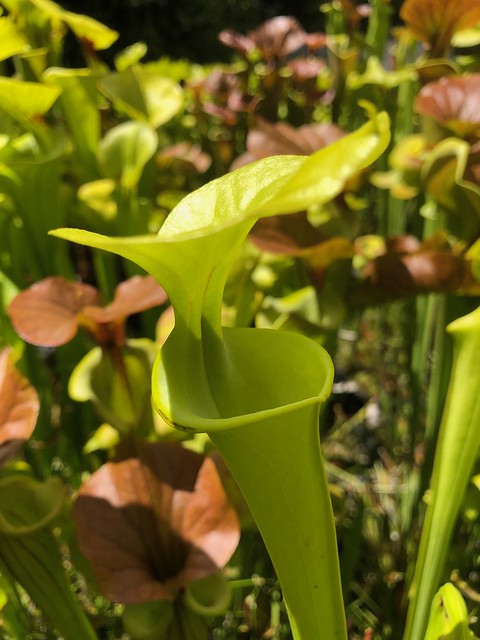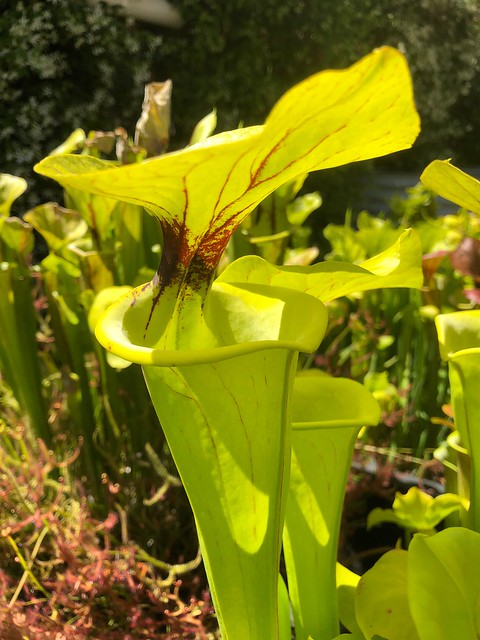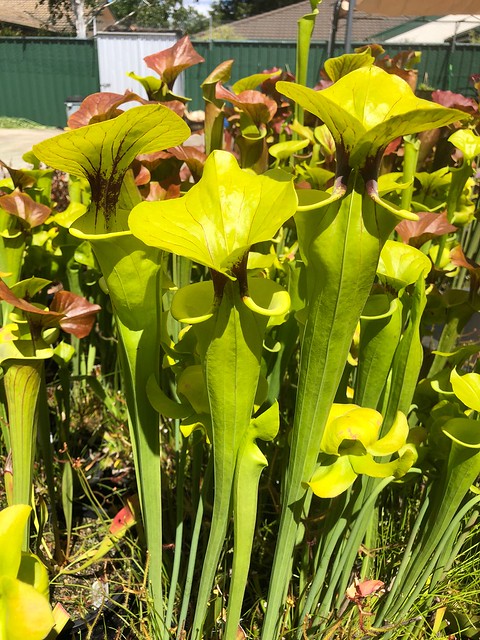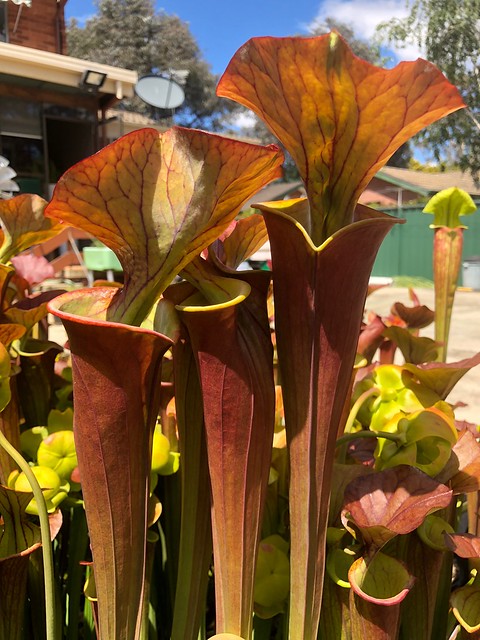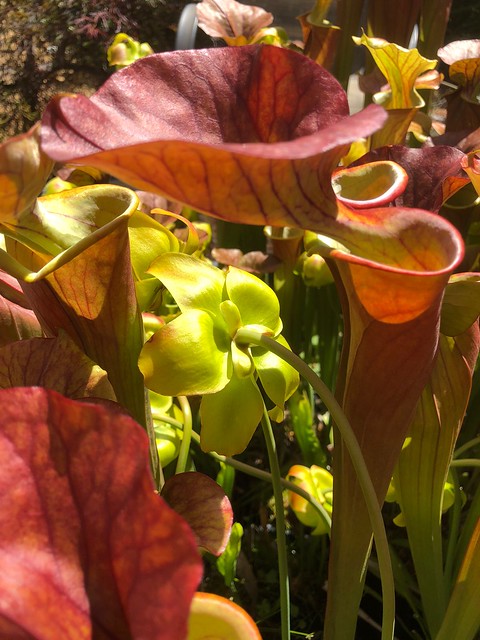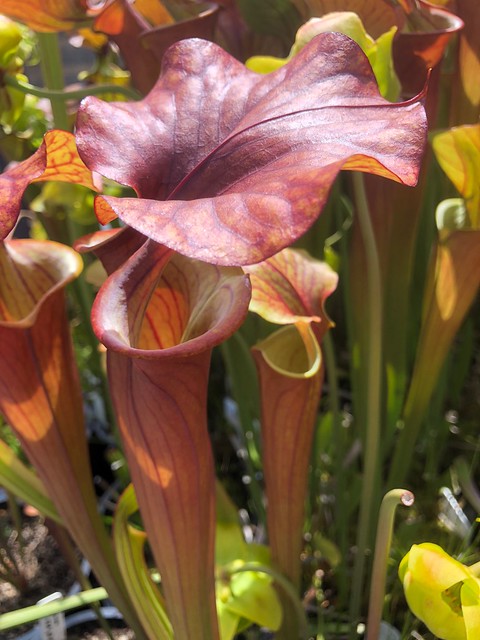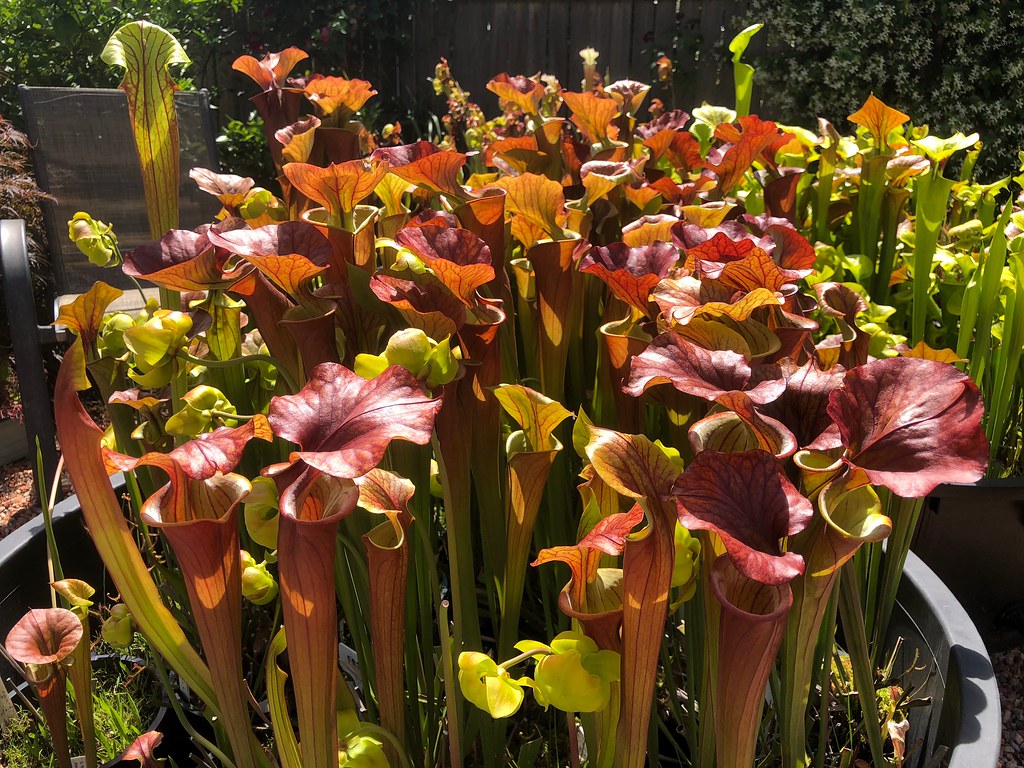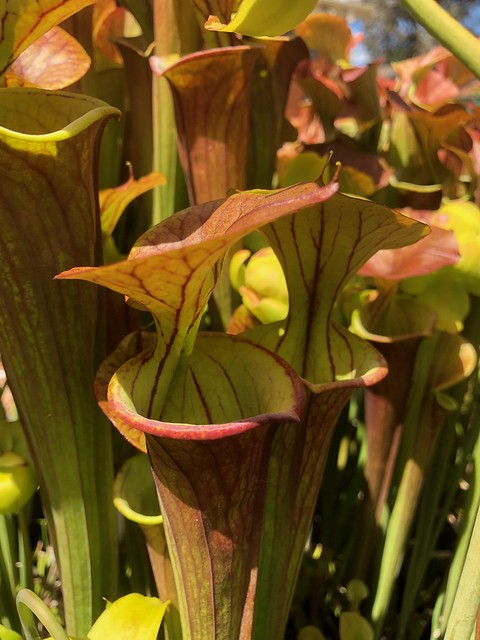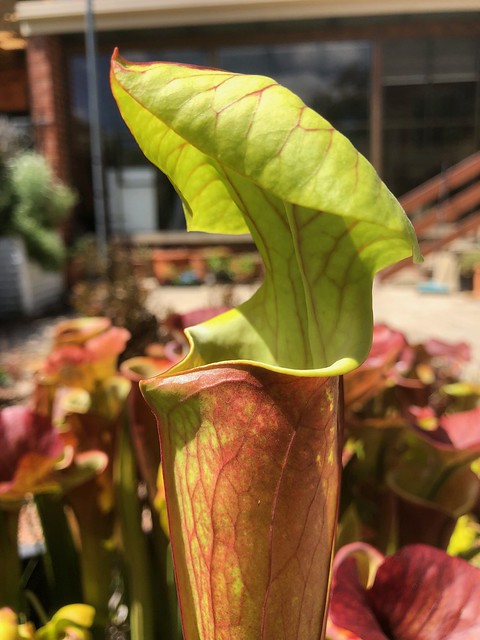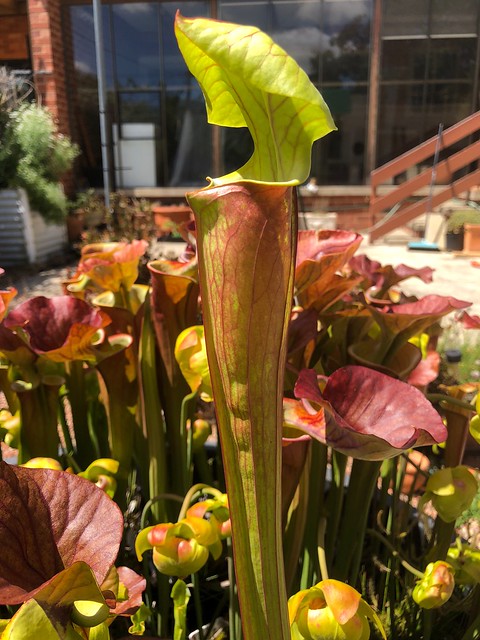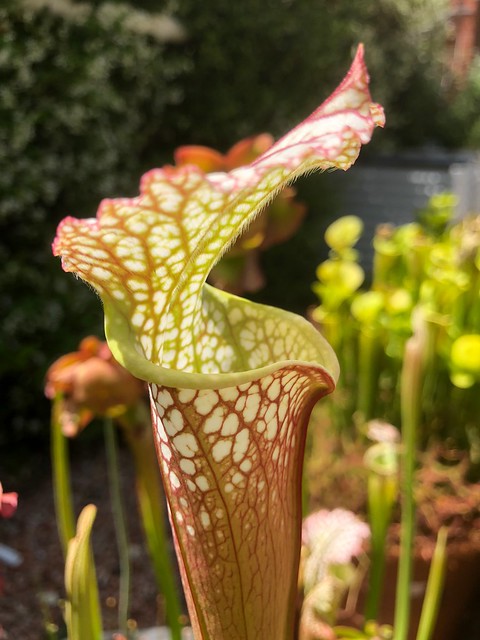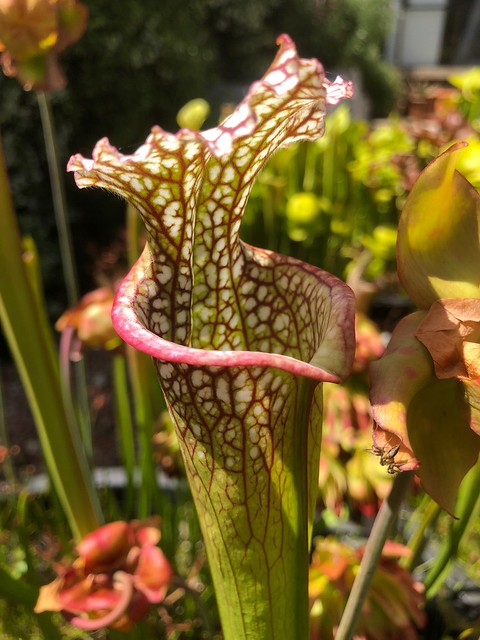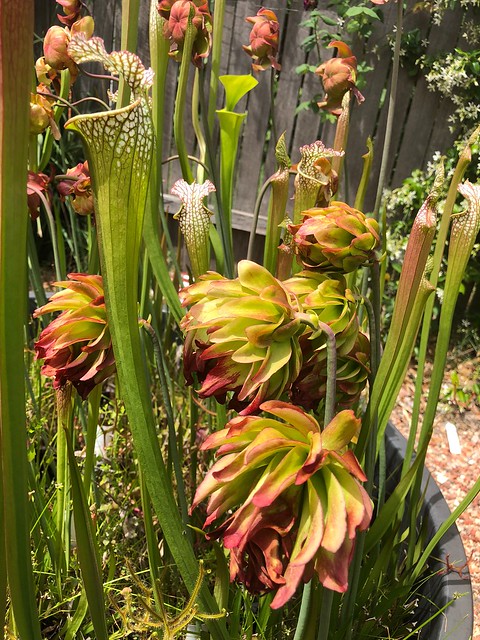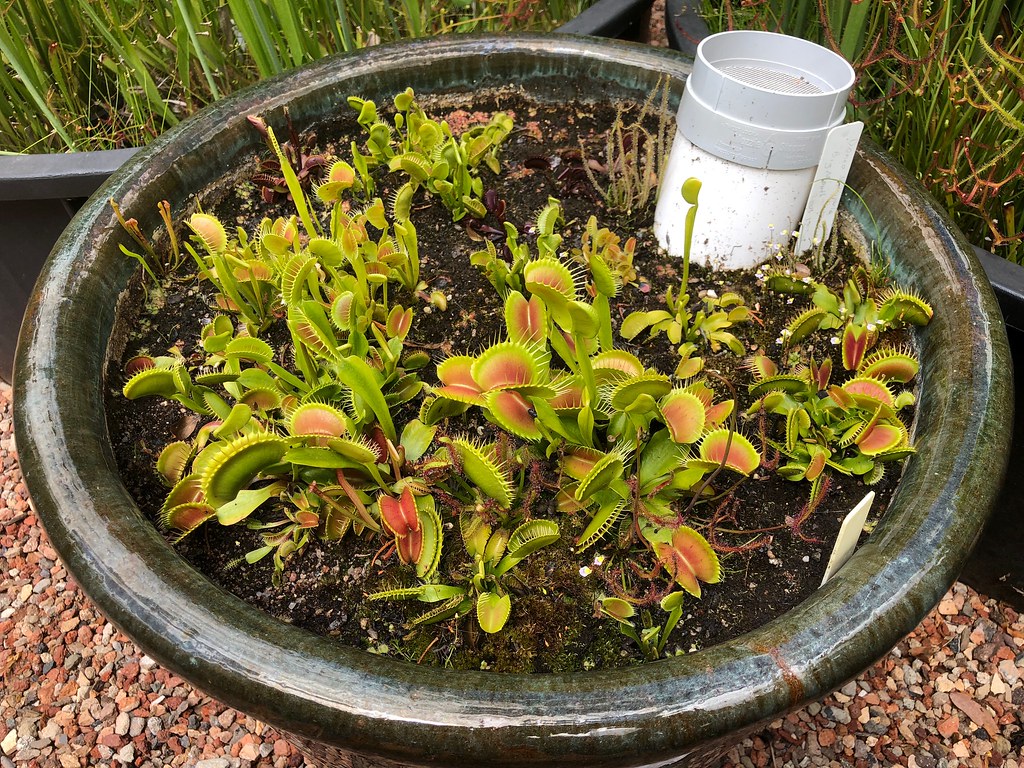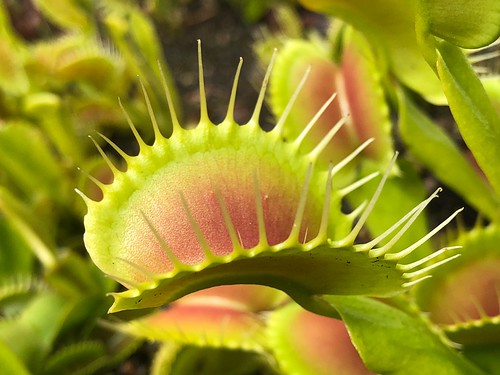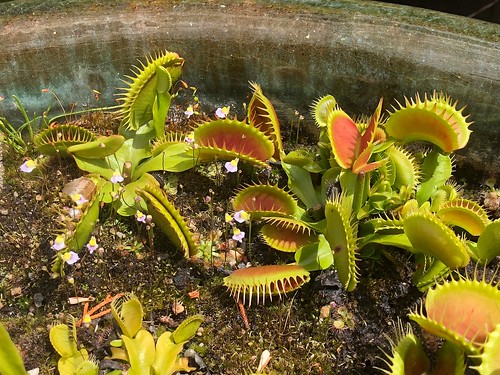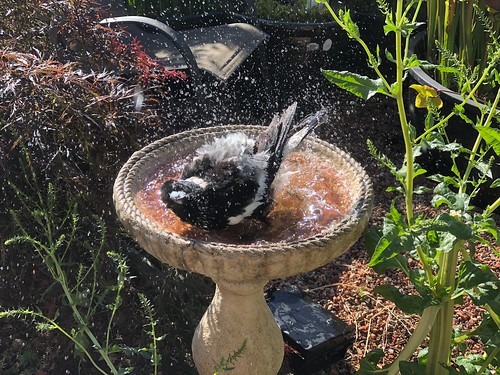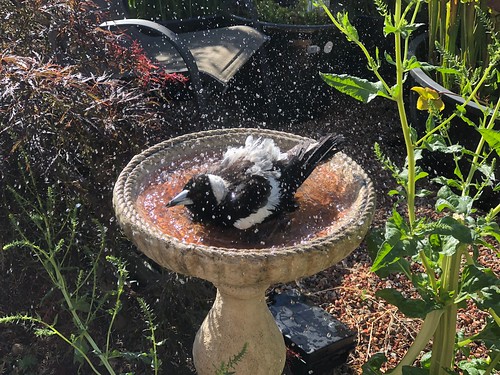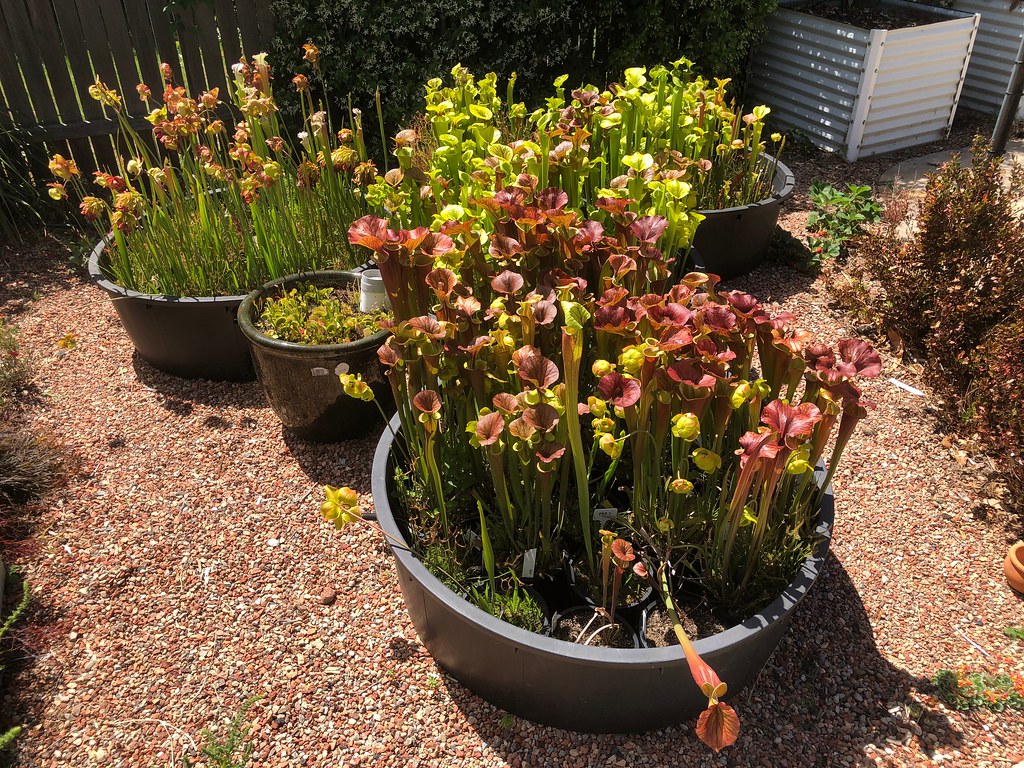
The Sarracenia flava have now hit their peak for the year, and look fantastic (with one exception). Its always a bit of an anxious time as the plants come up – will the wind topple them over this year? Are they going to colour up as well as last year? Its a poor season for insects, is it going to affect pitcher production? And so on. But as the plants open and colour up, most worries evaporate and its time to sit back, relax and enjoy the plants.
Here’s a guided tour of the Sarracenia flava this season:
These S. flava var. rugellii were brought at the 2011 AUSCPS Christmas party in Sydney from grower Phil Reyter. I’ve had mixed luck with rugellii; my first was a clone from Gotcha! Plants started out ok, but remained somewhat on the small side and is sensitive to repotting – it seems to be a bit of an underperformer relative to other clones I’ve had since, with Phil’s being one of the better ones. This clone is unfortunately slow to build up to a good size.
A new acquisition from 2016 (thanks Owen!), this var. rugellii is another good clone. Its exceptional for being a strong divider that forms good sized clumps, and also for its huge lid. Like all rugellii I’ve ever grown, it only produces a pitcher or two per growing point, but the clumping habit makes up for this.
Another plant still establishing in the collection after I re-acquired it from Ron Abernethy last year, at right is S. flava var. cuprea x rugellii. Ron tells me this cross was a mistake – he crossed the wrong flower! This plant is sold by Triffid Park and seems to have been exported to a number of countries, so its not done badly at all for an accidental production. Triffid Park now sell one of its siblings as “Brass Top” (ie. Ron tells me '”Brass Top” is from the same cross, but is a different clone). It is a very good clone that performs extremely well, and looks great with the cut throat and heavy veining.
A perennial good performer, this var. cuprea is one I call ‘Gotcha! Plants heavy vein’. Gotcha (John Creevey) brought it as seed from Allen Lowrie sometime during the 1980s or 1990s. The veins have not filled in fully yet, and the lid will be very rich copper in colour by midsummer.
This beautifully coloured plant is a new one for 2018 – it is a clone grown for many years by fellow Canberra grower Ross Rowe. It outperforms every other var. cuprea I’ve grown in terms of how strongly coloured its hood is. I wonder if it may well come up as an all (or nearly all) red plant in years to come.
In spring 2011, I selfed every S. flava flower I had open and sowed the seeds out in summer 2012. The first of these plants are now at flowering size (I didn’t use any fertiliser to help them along). The above and below plants are some of the progeny. Above left is a var. rugellii and a var. cuprea, and at right a var. flava with a pitcher mouth that fills in all red. They will need their own pots next year, so I’ll carefully put some labels with their rhizomes to mark out what plant is what.
Another seedling I’m very happy with is this S. flava var. rubricorpora (in fact, its the only rubricorpora that coloured up this season). Its the progeny of David Martin’s rubricorpora clone “FRT-1”, which has been badly set back (along with the other rubricorpora in my collection this year) for some reason.
A couple of more var. cuprea – at left is a clone I got from Owen O’Neill in 2016, and at right David Martin’s F1, which is now approaching 40 years of cultivation.
Here’s some flava var. flava – at left is a clone from Owen O’Neill, and at right, one of the plants I brought at the 2007 ICPS conference in Sydney that re-started my collection. It was one of a number of plants that Greg Bourke donated to the Sydney Botanic Gardens, grown from seed. The parent plant was from a flava population on Honeysuckle Road at Harleyville, North Carolina.
Another var. flava, this plant is a very tall clone (biggest pitcher was 74 cm this year) that was grown by legendary Pinguicula grower Helmut Kibelis. Its the largest of my flava this year, but is a few centimetres smaller than one of the leucophylla spring pitchers. It looks like a var maxima, but always gets a tiny amount of red venation.
And to finish the var. flava – this handsome plant was also from Helmut, who told me he believed it to be the same as what people in Germany were growing as “Maxima” in the 1980s. As clones get circulated, it is easy for their identity to get confused, and that indeed is what happened with this plant. A quick search shows the plant grown by Slack and distributed as “Maxima” (now as “Slack’s Maxima”) is different, with a smaller hood and more venation. Nonetheless, this is a magnificent clone that always looks great. I’ll refer to it as ‘Helmut’s Maxima’ from now on.
On to the flava var. atropurpurea. FRT 1-1 is putting up a spectacular display as always.
My favourite plant, I’ve more or less dedicated an entire growing pond to it.
This is a clone of atropurpurea from Blackwater State Forest in Florida. It flowered for the first time this year, and it was used to cross pollinate every other atropurpurea in my collection!
To finish up the atropurpurea, at left is another David Martin clone, FRT1-5. At right is a var. maxima I grew until a few years back when I accidentally sold my divisions of it to Owen. It is a tall but robust plant that will eventually produce a weakly copper hood.
As a sort of segue into the leucophylla spring pitchers, here’s a flava x leucophylla (= x moorei) backcross from David Martin. Its a slow grower, but produces magnificent rubricorpora-esq. pitchers. This pitcher is 72 cm tall.
Here are some of the leucophylla spring pitchers, which are always taller and have different patterning and colouration to the autumn pitchers. The pitcher at left is the largest in the Sarracenia collection this year, standing at 77 cm.
And to finish off the Sarracenia - above left is luecophylla cv. “Tarnok”, with its unusual flowers, and at right, a red-veined leucophylla about to open. I’m half tempted to cash-in my leucophylla for S. purpurea after having seen purpurea in the wild earlier this year, but will wait to the end of the season to decide.
Here’s the VFT collection in their own minibog, which is doing very well considering I lost all my plants last year.
One plant I found buried under some Sarracenia late last season is the all-red VFT bred and circulated by Peter and Jessica Biddlecombe during the 1980s and 1990s. While not a bad clone, it seems to have been dropped by everyone for newer clones like Pink Venus, Aki Ryu and Red Velvet. I’m also using the VFT minibog for Drosera, which (besides D. binata) get overshadowed by the Sarracenia. The Drosera burmannii and D. pulchella I acquired last season seem to have taken to the garden well too.
Some more VFT: at left: B52, and right: Low, Giant.
And to close off – here’s one of the cheeky neighbourhood Magpies (Gymnorhina tibicen tibicen) having a wash in the bird bath next to the Sarracenia.

